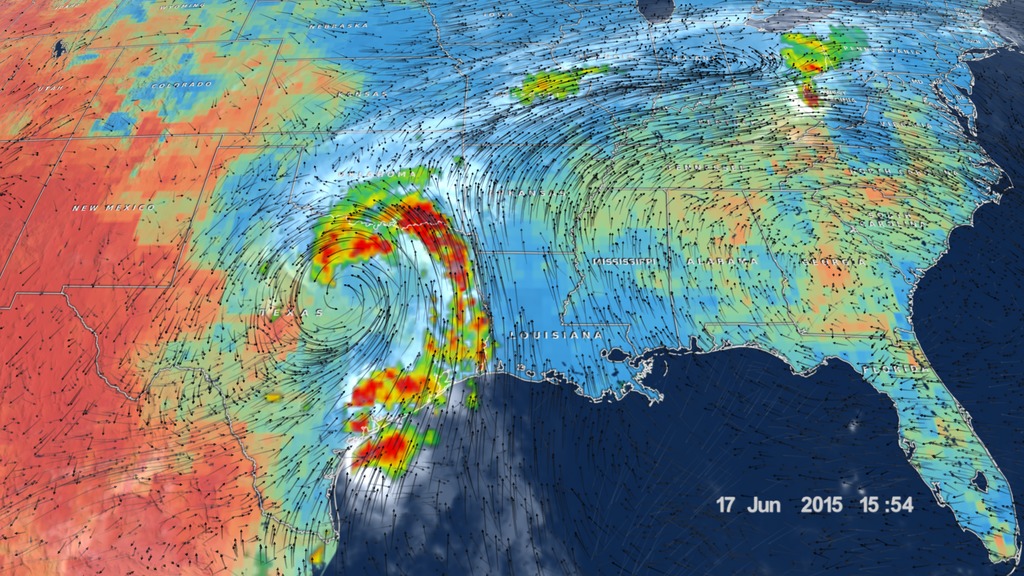Tropical Storm Bill Over Texas
Visualization of rainfall over Texas as Tropical Storm Bill further drenched the state with rain on June 17, 2015 at 6:11:27Z. Shades of blue indicate frozen precipitation in the atmosphere and shades of green to red show liquid precipitation.
Tropical Storm Bill made landfall over Texas at approximately 11:45am CST on June 16, 2015. Shortly after midnight, GPM passed over the storm as it slowly worked it's way northward across the already drenched state of Texas. This visualization shows Bill at precisely 12:11:27am CST (6:11:27 GMT) on June 17, 2015.
The GPM Core Observatory carries two instruments that show the location and intensity of rain and snow, which defines a crucial part of the storm structure – and how it will behave. The GPM Microwave Imager sees through the tops of clouds to observe how much and where precipitation occurs. The Dual-frequency Precipitation Radar provides the three-dimensional view, showing the structure of the storm spiraling inward toward the center, with heavier rain on the north side of the storm. Shades of blue represent ice in the upper part of clouds. Viewed from the side, the stark color change from blue to green marks the transition from ice to rain.
For forecasters, GPM's microwave and radar data are part of the toolbox of satellite data, including other low Earth orbit and geostationary satellites, that they use to monitor tropical cyclones and hurricanes.
The addition of GPM data to the current suite of satellite data is timely. Its predecessor precipitation satellite, the Tropical Rainfall Measuring Mission, after 18 years of operation was deorbited June 16 (the same day Tropical Storm Bill made landfall). GPM's new high-resolution microwave imager data and the unique radar data ensure that forecasters and modelers won't have a gap in coverage. GPM is a joint mission between NASA and the Japan Aerospace Exploration Agency. All GPM data products can be found at NASA Goddard's Precipitation Processing Center.

Color bar for frozen precipitation rates (ie, snow rates). Shades of cyan represent low amounts of frozen precipitation, whereas shades of purple represent high amounts of precipitation.

Color bar for liquid precipitation rates (ie, rain rates). Shades of green represent low amounts of liquid precipitation, whereas shades of red represent high amounts of precipitation.

Print resolution still of GOES East cloud cover data with GPM/GMI ground precipitation over Texas shortly after midnight on June 17, 2015.

Print resolution still of GPM/GMI ground precipitation data from Tropical Storm Bill over Texas shortly after midnight on June 17, 2015.

Print resolution still of Tropical Storm Bill being bissected to show the inner structure of volumetric rain rate date derived from GPM's DPR sensor.

Print resolution still showing a side view of Tropical Storm Bill shortly after midnight on June 17, 2015. Notice the intense (red) rainfall rates within the storm as well as very dense frozen precipitation (purple) reaching high up into the atmosphere.

Print resolution still of Tropical Storm Bill shortly after midnight on June 17, 2015.
Credits
Please give credit for this item to:
NASA's Scientific Visualization Studio
-
Visualizers
- Alex Kekesi (Global Science and Technology, Inc.)
- Greg Shirah (NASA/GSFC)
-
Scientists
- Gail Skofronick Jackson (NASA/GSFC)
- George Huffman (NASA/GSFC)
- Dalia B Kirschbaum (NASA/GSFC)
-
Producers
- Rani Gran (NASA/GSFC)
- Ryan Fitzgibbons (USRA)
-
Project support
- Eric Sokolowsky (Global Science and Technology, Inc.)
Release date
This page was originally published on Wednesday, June 17, 2015.
This page was last updated on Sunday, January 5, 2025 at 12:06 AM EST.
Missions
This page is related to the following missions:Series
This page can be found in the following series:Datasets used
-
Rain Rates (Surface Precipitation) [GPM: GMI]
ID: 822Credit: Data provided by the joint NASA/JAXA GPM mission.
See all pages that use this dataset -
Volumetric Precipitation data (Ku) [GPM: DPR]
ID: 830Credit: Data provided by the joint NASA/JAXA GPM mission.
See all pages that use this dataset
Note: While we identify the data sets used on this page, we do not store any further details, nor the data sets themselves on our site.

